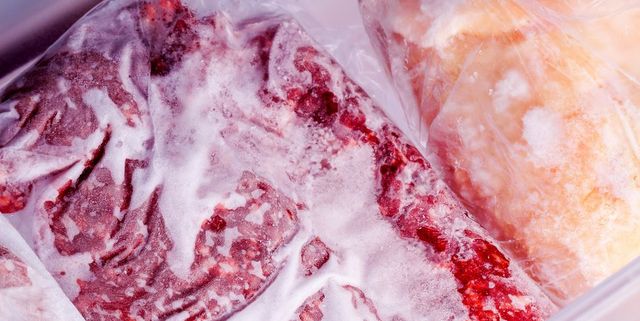Defrosting meat properly is just as important as knowing how to freeze it. Carrying out this process well will not only protect you from poisoning, but will also ensure quality and tasty food. For this reason, we find it very useful to share with you all the essential details of how to defrost meat and also some interesting tips.
In this useful guide you will have the three most recommended defrosting methods according to the experts, explained step by step and very didactically. In addition, we also tell you how to freeze meat effectively. Keep reading!
How to freeze meat?
The task of freezing meat is not very complicated, although you do need to consider some essential details to carry it out with good results. Here’s how to do it:
- Know the potential of your freezer. Home freezers are categorized by stars from 1 to 4 (-6º, -12º, -18º and -24º). Since food needs to be refrigerated at least below -18º, freezers between 1 and 3 stars serve to keep food frozen, but they do not guarantee an optimal process, so take it into account.
- Buy fresh and good quality meat. Do not buy products about to expire, because you run the risk of spoiling them during the process. Likewise, avoid freezing minced meat as much as possible, unless you are sure that it is very fresh; in this case you could freeze it. Finally, in the supermarket, he puts the meat almost at the end of the purchase.
- Prefer cuts that are easier to freeze. All meats, without exception, can be frozen, although some are better than others for this process, either because of their ease of handling or because of their organoleptic characteristics. In this sense, keep in mind that lean pieces resist freezing better than pieces with a higher fat content.
- Freeze meat as soon as possible. Preferably do it right away. Keep in mind that although the package indicates that it is several days away from being damaged, during that time it begins to deteriorate slowly. In other words, if you wait too long, you will significantly reduce the durability of the product.
- Throw away the paraffin paper and the tray it comes with. The trays are made of a thermally insulating material known as XPS, which slows down freezing, takes up a lot of space, and isn’t always hermetically sealed. On the other hand, parchment paper does not work well for freezing food.
- Remove visible bits of fat. Fats tend to turn hard and therefore tend to speed up the breakdown of the rest of the meat.
- Store meat in portions. If it is a large piece, cut it into portions of 200-250 grams. In this way, you will obtain several advantages: you will be able to handle the meat more easily, the pieces will take less time to freeze and it will be even, you will only defrost the necessary meat and the defrosting process will be easier and safer.
- Wrap the meat portions very well. Do it first with plastic wrap and then put them in special plastic bags or containers for freezing. If you use bags, squeeze all the air out of them and close them tightly. Another option to freeze meat without sticking would be to have a homemade vacuum sealer.
- Freeze large cuts in their original bag. We refer to products such as pork leg, roast, round, etc. In these cases, check the package and check that it is hermetically sealed, otherwise, store the product in large special freezer bags or seal them with plastic wrap.
- Label the containers. Give them the date of purchase, the day you froze them (if you didn’t freeze them on arrival), and the name of the product.
- Take control. Have a list in a notebook or any electronic device (mobile, computer or tablet). A good idea is to create a list in Excel.
Tip: wash your hands before and after handling any type of raw meat to avoid food contamination.
How to defrost meat correctly?
The US Department of Health and Human Services recommends keeping thawed foods no hotter than about 4.44º. For this reason, slow thawing in the refrigerator is the best option because it does not break the cold chain, consequently, it better preserves the organoleptic characteristics of the food and its decomposition does not accelerate as much once thawed. But if you need a quicker, safer method, cold water immersion will do the trick. With that said, let’s look at how to safely defrost meat using these methods:
How to defrost meat gradually?
Cuts of less than 2 kilos need approximately 12 hours, so you can defrost them overnight before preparing them. Now, if you’re wondering how to thaw roast beef, as well as other large pieces, it can take about 24 hours for every 2.5kg of meat. In these cases, you should check the meat every 24 hours, since you need to make sure if it is already defrosted. Without further ado, we recommend reviewing the following steps:
- Transfer the meat from the freezer to the refrigerator. Never thaw meat with hot water or leave it at room temperature.
- Place a deep plate or roasting pan under the meat. The idea is to prevent the liquid products of the thawing process from touching the meat. An interesting suggestion is to place a rack over a bowl or roasting pan, put the meat on top and, finally, place both on the bottom floor, towards the bottom. In addition, this practice avoids the contamination of other foods.
- Keep it before cooking. If you plan to consume it in a while or the next day, do not leave it at room temperature and keep it in the fridge. Ground meat, fish and poultry can be left for approximately 1-2 days, while beef, pork, veal or lamb can last for approximately 3-5 days.
How to defrost meat fast with cold water?
This method allows you to defrost 1 piece of meat weighing between ½ kilo and 1 kilo in approximately 15-30 minutes. If it is a piece of 2.5 kilos, it will take you about 1 hour. Finally, if you have cuts from 2.5 kilos you will need about 2-3 hours. That said, here are the steps to follow to know how to defrost meat with water:
- Put the piece in a bag. If it’s already in one, leave it there. Instead, if it’s in a plastic container or other material, transfer it to a zip-lock bag.
- Check that the bag is well closed. This is very important, because no water should enter it.
- Submerge the bagged meat in cold tap water. Tap water has a temperature that ranges between 7 and 10 degrees Celsius.
- Change the water every 30 minutes to keep it very cold. When defrosting meat with water, never allow it to reach 30-42 degrees Celsius. For this reason, if you live in a very hot place, you may need to change the water more often and add 1-2 ice cubes.
- Cook the meat as soon as it thaws. Quick thawing methods accelerate the growth of bacteria.
How to defrost meat in the microwave?
You can never miss an express method in the kitchen and the most effective in this case is the microwave. Although it must be recognized that using heat to defrost meat is not the most advisable, the only safe way to do it is by using this device. Thawing with hot water and leaving the meat at room temperature are completely ruled out. That said, here is a step-by-step guide on how to quickly defrost meat in the microwave:
- Unpack the meat and place it on a microwave-safe plate or container. If you want to defrost vacuum-packed meat, you will have to break the vacuum and remove it from the bag.
- Program the option to defrost or defrost. Some microwaves will ask you for the weight of the meat, in this way, it will calculate the time necessary for this function. If not, the next step will guide you.
- Put the time according to the type of meat and the weight. Bone-in chicken (per 700g), ground beef (per 700g), beef steaks (per 450g), and bone-in pork (per 450g), need to start at 50% power for 2 minutes. After this time, reduce the power to 30% for 1 minute. For boneless chicken breasts (per 700g), everything stays the same, except the final potency is reduced to 20%. Instead, for boneless pork chops or steaks (per 250g), do it all over again changing the power to 40% at the start and 30% at the end. These time and power references are indicative, since they can change depending on your microwave.
- Defrost at timed intervals. Keep in mind that microwaves are different from each other when it comes to power. For this reason, the total defrost time may vary. Work at 1-2 minute intervals at first and after 30 seconds. If your microwave isn’t very powerful, you can increase the time to 3 minutes at first.
- Check the state of the meat at each pause and turn it over. Check its texture by poking it with a fork in several places, if it feels soft in general, it is ready. Now, if you have several pieces at once, remove the thawed ones. If you’re still wondering how to defrost minced meat this way, simply removes the ready parts and continue the process with the rest to prevent it from cooking.
- Cook it immediately and using high temperatures. This way you will avoid the accelerated proliferation of bacteria caused by thawing with heat.
- Clean the microwave. In this way, you prevent food contamination after defrosting meat quickly.



